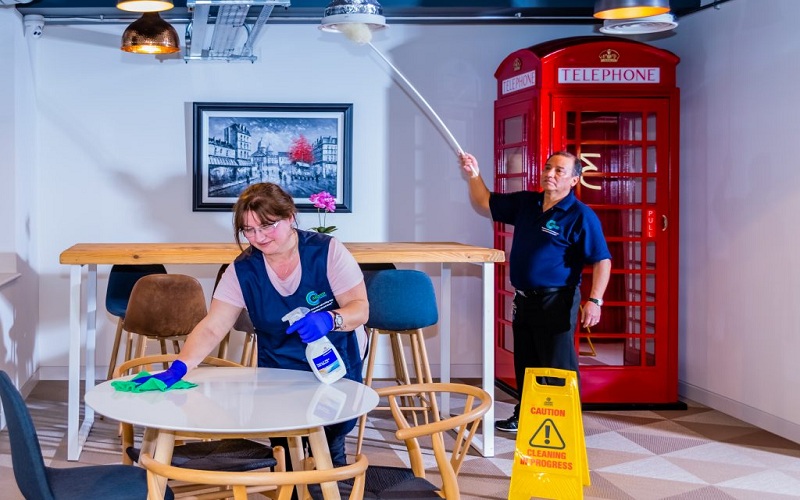The Unique Cleaning Challenges of Financial Institutions
Banks are more than just buildings where money is stored and transactions occur. They’re complex environments that require a delicate balance between security and cleanliness. This balance presents unique challenges for cleaning staff and bank management alike.
Why Bank Cleanliness Matters
A clean bank:
- Instills confidence in customers
- Protects the health of staff and visitors
- Preserves sensitive equipment and documents
- Maintains the professional image of the institution
- Complies with health and safety regulations
Key Areas of Focus in Bank Cleaning
1. Public Spaces
The lobby and teller areas are the face of the bank. They require:
- Regular disinfection of counters and writing surfaces B. Frequent cleaning of door handles and push plates C. Sanitization of pens and other shared items D. Thorough vacuuming and mopping of floors E. Cleaning of seating areas and tables
- ATM and Self-Service Areas
These high-touch zones need special attention:
- Disinfection of keypads and touch screens
- Cleaning of card readers and cash dispensers
- Sanitization of surrounding surfaces
- Regular checks for cleanliness throughout the day
III. Private Offices and Meeting Rooms
While less trafficked, these areas still require:
- Daily dusting and vacuuming
- Sanitization of desks and work surfaces
- Cleaning of phone handsets and computer peripherals
- Disinfection of door handles and light switches
- Vault and Security Areas
Cleaning these sensitive areas demands:
- Strict adherence to security protocols B. Use of approved cleaning agents that won’t damage equipment C. Careful handling of any documents or sensitive materials D. Coordination with security personnel for access.
- Employee Break Rooms and Restrooms
These areas require thorough and frequent cleaning:
- Regular sanitization of all surfaces
- Deep cleaning of appliances like microwaves and refrigerators
- Frequent restocking of soap and paper products
- Proper disposal of waste and recycling
Balancing Security and Sanitation
Maintaining cleanliness without compromising security is paramount. Here’s how to strike that balance:
- Vet cleaning staff thoroughly
- Provide security training for cleaners
- Use supervised cleaning teams in sensitive areas
- Implement a check-in and check-out system for cleaning equipment
- Schedule cleaning during off-hours when possible
The Role of Professional Cleaning Services
Many banks find that partnering with commercial cleaning services San Diego CA offers can help maintain this delicate balance. Professional cleaners bring:
- Specialized training in security-sensitive environments
- Knowledge of appropriate cleaning products and techniques
- Efficient cleaning processes that minimize disruption
- Flexibility to work around banking hours
- Consistent and reliable service
Cleaning Products and Techniques for Banks
When selecting cleaning products and methods, consider:
- Non-abrasive cleaners for delicate surfaces
- Fast-drying disinfectants for high-traffic areas
- Low-odor products to maintain a professional atmosphere
- Microfiber cloths to reduce lint and dust
- HEPA vacuum filters to improve air quality
Creating a Comprehensive Cleaning Schedule
A well-planned cleaning schedule should include:
- Daily tasks: Vacuuming, trash removal, surface disinfection
- Weekly tasks: Deep cleaning of floors, dusting of high areas
- Monthly tasks: Cleaning of windows, deep cleaning of carpets
- Quarterly tasks: Cleaning of light fixtures, HVAC vents
Adjust the frequency based on foot traffic and specific bank needs.
Training Bank Staff in Cleanliness Practices
While professional cleaning is essential, bank employees play a role too:
- Encourage regular handwashing
- Provide sanitizing wipes for workstations
- Train staff to keep personal areas tidy
- Implement a clean-desk policy for sensitive documents
- Educate employees on proper handling of shared equipment
Measuring Cleaning Effectiveness
To ensure cleaning protocols are working:
- Conduct regular cleanliness audits
- Solicit feedback from staff and customers
- Monitor absenteeism rates among employees
- Perform periodic testing for bacteria levels on surfaces
- Review security footage to ensure cleaning staff follow protocols
Adapting to Changing Needs
As banking practices evolve, so should cleaning protocols. Stay flexible and ready to adapt to:
- New technologies in banking equipment
- Changes in customer behavior and traffic patterns
- Updates to health and safety regulations
- Emerging cleaning technologies and products
- Shifts in bank layout or services offered
The Future of Bank Cleaning
Looking ahead, we can expect to see:
- Increased use of antimicrobial surfaces
- Implementation of UV disinfection technologies
- Greater integration of cleaning protocols with security systems
- More environmentally friendly cleaning practices
- Enhanced air filtration systems
A Clean Foundation for Financial Trust
A clean bank is more than just a tidy space—it’s a statement of professionalism, care, and attention to detail. By implementing thorough cleaning protocols that respect the unique security needs of financial institutions, banks can create environments that inspire confidence and protect the well-being of everyone who walks through their doors.
Remember, the goal is to create a space where financial transactions can occur smoothly and safely, free from both security concerns and health risks. With careful planning, the right partners, and a commitment to excellence, banks can achieve the perfect balance of security and sanitation, setting the stage for successful financial relationships and transactions.

